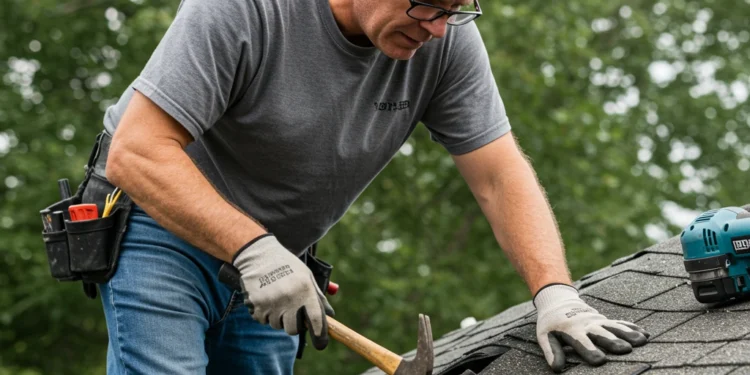Your roof is the barrier between your home and everything Mother Nature throws at it. Without regular care, minor issues can turn into major repairs. Working with an expert team for roof cleaning ensures your roof stays functional, beautiful, and long-lasting—without the risks of DIY mistakes.
What “Roof Maintenance” Actually Means
Think of maintenance as three buckets:
- Inspection: Visual checks (ground + roofline), attic spot checks, and photos to document changes.
- Cleaning: Clearing organic growth (algae, moss, lichen), removing debris, and washing with the right method (soft washing, not high PSI).
- Minor fixes: Re-sealing flashings, replacing broken shingles/tiles, tightening fasteners, unclogging gutters/downspouts.
For most homes, a bi-annual routine (spring/fall) + post-storm check is ideal.
The Cost of Skipping Maintenance
- Leaks & interior damage: Small flashing failures or nail pops become ceiling stains, insulation damage, and mold remediation—expensive fast.
- Accelerated roof aging: Algae and moss hold moisture; granule loss follows, shortening shingle life.
- Voided warranties: Manufacturer & workmanship warranties commonly require proof of “regular maintenance.”
- Higher energy bills: Blocked vents and dark biological growths can raise attic temps and strain HVAC.
- Insurance headaches: Some carriers deny or reduce claims when there’s evidence of neglect.
Why Soft Washing Beats High-Pressure
Pressure can blow off granules, scar shingles, and force water under laps. Soft washing uses low pressure plus roof-safe detergents to break down growth and rinse gently.
Best practices you should insist on:
- Use manufacturer-approved cleaning solutions and dwell times.
- Pre-wet and protect landscaping; neutralize runoff where needed.
- Rinse fixtures, metal flashings, and solar hardware.
- Photo documentation before/after.
The Roof Maintenance Checklist (Homeowner Edition)
Use this list to stay proactive—or hand it to your pro and ask them to document each step.
Seasonal (Spring/Fall)
- Clear leaves, pine needles, and branches from roof and valleys.
- Clean gutters and downspouts; confirm full flow at ground.
- Inspect shingles/tiles for cracks, curling, or displacement.
- Check flashing at chimneys, skylights, vents, and wall junctions.
- Look for nail pops, lifted edges, or missing ridge caps.
- Confirm soffit and ridge vents are clear.
- From the attic: check for damp insulation, discoloration, or daylight at penetrations.
After Severe Weather
- Walk the property perimeter; use binoculars if needed.
- Look for impact marks, new granules at downspouts, bent gutters, or missing pieces.
- Schedule a documented inspection if anything changed.
Annually (Professional Tasks)
- Soft wash to remove algae/moss/lichen as needed.
- Re-seal/replace failing flashings and pipe boots.
- Tighten exposed fasteners (metal roofs).
- Treat moss/lichen and add zinc/copper strips if appropriate.
- Provide a written report with photos and recommendations.
Suggested Maintenance Rhythm (Typical Roof Types)
| Roof Type | Routine Clean | Pro Inspection | Notes |
| Asphalt Shingle | Every 12–24 months | Every 12 months | Avoid pressure; protect granules |
| Tile (Concrete/Clay) | 12–24 months | 12 months | Watch for cracked tiles, underlayment aging |
| Metal (Standing Seam) | 18–24 months | 12 months | Check fasteners, sealants, and oxidation |
| Cedar Shake | 12 months | 6–12 months | Moisture management is critical |
| Flat/Low-Slope | 6–12 months | 6 months | Keep drains/scuppers clear; watch ponding |
Adjust frequency for heavy tree cover, coastal salt, high humidity, or north-facing slopes.
ROI: Maintenance vs. Early Replacement
- Maintenance: predictable, low cost; extends life and keeps warranties intact.
- Deferred maintenance: a few small failures cascade into sheathing rot, interior repairs, and premature replacement—often the most expensive path.
A good rule of thumb: if your roof is mid-life and structurally sound, routine cleaning + minor repairs almost always costs less over 3–5 years than “wait and see.”
Safety First (Non-Negotiables)
- Work from the ground whenever possible (extension poles, cameras, drones).
- If climbing is required, use fall protection and walk pads; avoid fragile tile edges.
- Keep people, pets, and plants protected during chemical application.
If a contractor can’t explain their safety protocol in plain English, get another quote.
Common Myths—Busted
- “Black streaks are just cosmetic.” They’re often algae colonies that retain moisture and accelerate wear.
- “Pressure washing is faster and cheaper.” It’s costly when it rips granules or floods laps—soft wash is the correct method for most roofs.
- “If it’s not leaking, it’s fine.” Most leaks start small and invisible; inspections catch them before they reach drywall.
How to Choose a Roof Maintenance Pro
- Method: Soft wash for most pitched roofs; specialized approaches for tile/metal/flat.
- Proof: Before/after photos, written report, references.
- Insurance & licensing: Verify both; request certificates.
- Materials: Manufacturer-approved detergents; plant protection plan.
- Warranty: Clear workmanship warranty on cleaning and minor repairs.
Looking in [Your City/Service Area]? Book a free roof assessment with [Your Brand] and get a photo report you can keep for insurance and warranty records.
FAQs
How often should I clean my roof?
Every 12–24 months for most homes; more often with heavy tree cover, shade, or high humidity.
Will cleaning void my roof warranty?
No—using approved methods helps protect warranties. Aggressive pressure cleaning might void coverage; ask your contractor to document products and process.
Can I DIY?
Ground-based debris removal is fine. For roof-level work, chemicals, or walking on the surface—hire a pro for safety and to avoid damage.
What about solar panels?
Coordinate cleaning so panel mounts, conduits, and roof penetrations are inspected and re-sealed where necessary.












